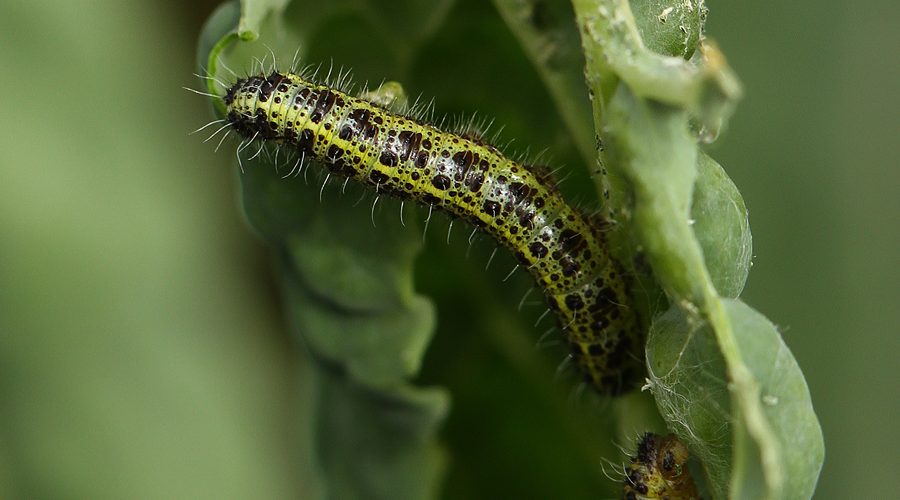Get ahead of the game by being prepared for some of the most common pests and diseases in the veg patch…
Aphids & White Fly
These tiny little things are smaller than ants and you’ll often find them in colonies on the stems of veg plants. They absolutely love broad beans and tomatoes, but can make themselves at home on any plant really. They suck out the juices from the plant making the plant itself somewhat weak and deformed so act quickly if you find them by spraying them off with a good jet of water. To prevent them it helps to plant lots of marigolds and tagetes to attract ladybirds and lacewings which will eat those naughty aphids!
Birds
Pigeons in particular will enjoy pecking at your brassicas and leaves. If you wake one morning to find all the leaves have been nibbled down to their stems, then pigeons are the most likely suspects. To prevent this happening we strongly recommend putting some netting over brassicas and leaves.
Blight
This is mostly a problem with potatoes and tomatoes. You’ll recognise it by brown patches on the leaves initially, which will then travel down the stems and eventually to the potatoes/tomatoes themselves. Assuming you’re growing organically there’s not much you can do about it once you’ve got it, so we recommend cutting off infected foliage as you see it – this will slow down the spread of blight and hopefully you’ll manage to get a crop. You can help to prevent it by ensuring you leave enough space between plants for air to circulate. For tomatoes, cut off any foliage that is close to the ground and try not to get the leaves wet when you water them.
Blossom End Rot
If you get black patches at the bottom of your tomatoes as they ripen, you’ve got blossom end rot! This is most often caused by periods of underwatering, so make sure you water your tomatoes regularly keeping the soil consistently moist.
Cabbage Root Fly
These guys lay their eggs at the base of brassicas (broccoli, cabbages, cauli ower etc) and when they hatch the larvae tunnel down into the soil and feed off the roots of the plant. If your brassicas suddenly wilt, this is most likely to be the problem. To prevent this, cut 10cm circles out of cardboard, cut a slit into the centre and place them around the base of each brassica plant. The larvae will struggle to find their way down into the soil.
Carrot Fly
Lots of brown tunnels in your carrots is the result of carrot ies..they lay their eggs which, when they hatch, bury down into the soil and nibble on your carrots. The very best way to prevent this is a barrier of horticultural fleece, or you can grow your carrots higher up on a raised bed as they can’t fly higher than about 50cm. You can also try planting onions and garlic chives in and around your carrots as the carrot flies don’t like the smell.
Caterpillars
Lots of large holes in leaves or leaves stripped back to their stalks is an indication that you have caterpillars. They are most likely to be found on brassicas but they can be anywhere in the veg patch. It’s definitely worth draping a layer of horticultural fleece over brassicas to prevent butterflies from laying their eggs in the first place. You can also try some companion planting – a row of nasturtiums planted next door to your veg will hopefully encourage the butter ies to lay their eggs there instead, leaving your veg relatively untouched. Check leaves, particularly the undersides, regularly for clusters of eggs which you can wipe off before they hatch. If you do get a caterpillar infestation, pick them off and move them elsewhere!
Flea Beetle
If you spot loads of tiny round holes in the leaves of any of your plants then you probably have Flea Beetles. Like fleas, they are very jumpy when disturbed! Covering plants with horticultural fleece will help to protect your crops.
Powdery Mildew
Courgettes, pumpkins, squashes, melons and cucumbers are likely to suffer from this from time to time. The leaves will develop silvery spots and patches of mildew. Don’t worry about it too much, but do try to minimise it by cutting off and destroying affected leaves. If you keep the plants well watered and mulched then you can help to prevent it.
Rabbits
You’ll soon know if you’ve got rabbits if your veg gets eaten! If you already know you have bunnies in the vicinity, it’s a good idea to build a rabbit proof fence around your veg patch. You could pop fleece over your veg crops instead.
Slugs & Snails
A slimy trail and lots of holes and bite marks in your plants is a sure sign that you’ve got slugs and snails. The very best way to keep this under control is to do a night time patrol with a head torch and a bucket…pop any slugs and snails that you find into the bucket as you check your veg beds and dispose of them as you see fit. If you have chickens they will love eating them for breakfast! You can also lay barriers of grit and broken up eggshells around the base of plants to deter slugs, or get a slug trap underway by burying a small yogurt pot into the ground and filling with cheap lager to entice the slugs away from your crops.

